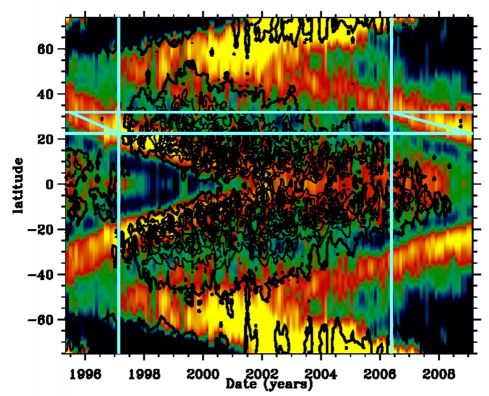The sun is currently at its lowest activity minimum in the last hundred years. Sunspots have been surprisingly few for the past two years. Now, for the first time, solar physicists are able to understand why * an underground flow feeding the sunspots has been moving slowly in recent years

At a press conference held this week by the American Astronomical Society in Boulder, Colorado, the researchers announced that underground jet streams move in the depth of the sun more slowly than usual, which increases the phenomenon of the absence of sunspots.
Rachel Hu and Frank He of the National Solar Observatory (NSO) in Tucson, Arizona used a technique known as helioseismology to discover and track the paths of the jet streams more than 7,000 km below the surface of the Sun. The sun produces new jet streams near the poles every 11 years, they explained. The jet streams move slowly from the poles to the equator and when the jet stream reaches the critical latitude of 22 degrees, a new cycle of sunspots begins to appear.
Huw and Hill found that the currents associated with the next solar cycle move lazily and take three years to cover a range of ten degrees of latitude compared to two years in the previous cycle. Now the current is finally reaching the critical latitude, heralding the return of solar activity in the coming months and years to come.
"It's exciting to see," Hill says, "because once this slow stream has reached the critical latitude, a year late, we start to see new groups of sunspots appear."
The current solar minimum has been so long and deep that it has led scientists to speculate that the Sun may enter a long period of no sunspot activity at all, reminiscent of the Maunder Minimum in the 18th century. These new results dispel the fear. The sun's internal magnetic dynamo is still working and the sunspot cycle is not "broken".
Because these jet streams flow below the surface of the Sun and cannot be directly observed, the years follow the movement of the streams using helio-seismology. Masses moving inside the sun send shock waves that row inside the sun and are therefore called "p modes" (the P comes from the word pressure). They circle around the inside of the sun and make it ring like a giant bell. By studying the vibrations of the sun's surface, it is possible to estimate what is happening inside it. Similar techniques are used by geologists to map the Earth's interior.
In this case, the researchers combined data from GONG and the SOHO satellite. Gong is short for "Global Oscillation Network Group." It is a network of telescopes scattered all over the world and measuring the fluctuations of the sun. SOHO makes similar measurements from space.
"This is an important discovery," says Dean Pensel of NASA's Goddard Space Flight Center. "It shows how flows within the Sun are involved in the formation of sunspots and how jet streams can affect the timing of the solar cycle."

However, there is still much to learn. "We don't yet understand exactly how the jet streams drive the creation of sunspots," Fensel said. "And we don't fully understand how the currents themselves are created." To solve these and other puzzles, NASA plans to launch the Solar Dynamics Observatory (SDO) satellite this year. This satellite will be equipped with helio-seismological sensors that will allow it to monitor the activity inside the Sun much better than in the past.
The helio-seismic and magnetic imaging instrument at SDO will improve our understanding of these and other internal currents by providing images of the entire solar disk to increasing depths," Fensel said.
Continuous monitoring of the jet streams in the Sun may help researchers do something they did not think possible before - predict with great precision the development of future solar cycles.

3 תגובות
It seems to me that the global warming situation is really serious. We are in a situation with a minority of sunspots
And yet the earth is warming.
to 1. There is a connection between the spots and magnetic storms (which can cause communication disturbances
and even power outages) on the one hand - and on the other hand, without spots, the sun is probably cooling down,
The period known as the "Little Ice Age" (between the middle of the 14th century and the middle of the 19th century)
Occurred at a time when there were few sunspots.
What is the effect of sunspots on the earth?